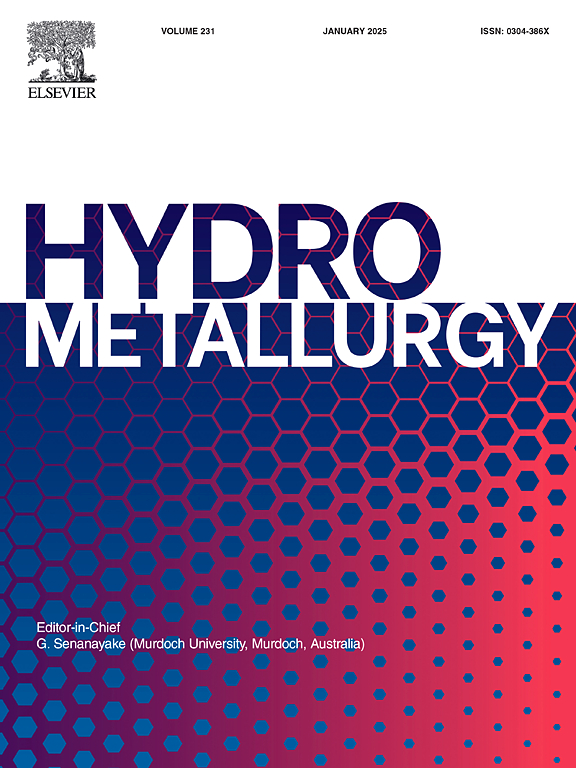利用酸性钛白废水可持续处理固体钛石膏废渣生产高价值α-半水石膏
IF 4.8
2区 材料科学
Q1 METALLURGY & METALLURGICAL ENGINEERING
引用次数: 0
摘要
钛石膏是二氧化钛生产厂家使用硫酸,用石灰中和废酸后产生的固体废物。钛石膏废渣全球年产量已达1000万吨。为了解决环境危害,本研究提出了一种低成本(2.39美元/吨)、无排放的方法,通过大量消耗钛石膏,可持续生产高价值α-半水合石膏。分离钛石膏中的原生铁杂质(>;80%)利用钛白废酸,得到高价值的红色氧化铁(Fe2O3)和绿色硫酸,即水合硫酸铁(FeSO4·7H2O)。此外,研究了钛石膏在无氯盐溶液中常压原位脱水的热力学过程,通过水化-再结晶生成20 μm大小的α-半水合石膏大颗粒。该研究提高了资源利用效率,减少了二氧化钛废酸和钛石膏对环境的污染,是一种对环境负责的工艺,对二氧化钛工业的可持续发展具有重要意义。本文章由计算机程序翻译,如有差异,请以英文原文为准。

Sustainable treatment of solid titanium-gypsum-waste using acidic titanium-white-wastewater to produce high-value α-hemihydrate gypsum
Titanium gypsum is a solid waste produced when titanium dioxide manufacturers use sulfuric acid and neutralize the waste acid with lime. The global production of titanium gypsum waste has reached 10 million tons annually. To address the environmental hazards, this study proposes a cost-effective ($2.39/ton), emission-free method to sustainably produce high-value α-hemihydrate gypsum by consuming large quantities of titanium gypsum. The primary iron impurity in titanium gypsum was separated (> 80 %) using titanium white waste acid, yielding high-value red iron oxide (Fe2O3) and green vitriol, i.e., hydrated iron(II) sulfate (FeSO4·7H2O). Additionally, the thermodynamic process of in-situ dehydration of titanium gypsum at atmospheric pressure in a chlorine-free salt solution was studied, producing large α-hemihydrate gypsum particles of 20 μm size through hydration-recrystallization. This work enhances resource utilization efficiency, reduces environmental contamination from titanium dioxide waste acid and titanium gypsum, and exemplifies an environmentally responsible process with significant implications for the sustainable development of the titanium dioxide industry.
求助全文
通过发布文献求助,成功后即可免费获取论文全文。
去求助
来源期刊

Hydrometallurgy
工程技术-冶金工程
CiteScore
9.50
自引率
6.40%
发文量
144
审稿时长
3.4 months
期刊介绍:
Hydrometallurgy aims to compile studies on novel processes, process design, chemistry, modelling, control, economics and interfaces between unit operations, and to provide a forum for discussions on case histories and operational difficulties.
Topics covered include: leaching of metal values by chemical reagents or bacterial action at ambient or elevated pressures and temperatures; separation of solids from leach liquors; removal of impurities and recovery of metal values by precipitation, ion exchange, solvent extraction, gaseous reduction, cementation, electro-winning and electro-refining; pre-treatment of ores by roasting or chemical treatments such as halogenation or reduction; recycling of reagents and treatment of effluents.
 求助内容:
求助内容: 应助结果提醒方式:
应助结果提醒方式:


